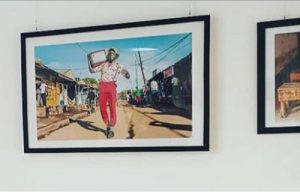
Overturning perception of art as elitist
Kampala, Uganda | DOMINIC MUWANGUZI | In any part of the world today, in any art gallery or museum of contemporary art, it is no longer unusual to encounter a black and white or coloured photo image sedately sitting behind a glass frame or a larger than life installation created from found objects (organic sand synthetic) occupying the gallery foyer. These types of artworks attest to the rapid evolution taking place in contemporary art globally. For artists to remain relevant to the ever- shifting tastes and preferences among the public and to tap into the increasingly advanced technologies in the present times, they have to innovate and create what community appropriate art. Additionally, this “new art” prompts reaching out to new audiences; the type that rarely patronises art galleries, to ensure a universal artistic movement that questions the ongoing of the everyday.
My first meeting with new art was in 2012 during the Visionary Africa- Art at Work itinerary workshop that happened in Kampala under the auspices of European Union and other partners. As part of the workshop, a pavilion was erected in the gardens adjacent to the Uganda Railway Station, along Jinja Road. The pavilion hosted a photography exhibition with a series of photos from Uganda’s post-colonial period until the mid-seventies.
Eminently showing was former President Idi Amin Dada photographed in what used to be his usual bravado style; wearing his uniform complete with ornamental military badges. I remember the exhibition curator, Simon Njami, remarking as he took us around the exhibit space that photography as an art form is unique because it is light and therefore palpable to larger audiences, unlike painting and sculpture that may necessitate a prior knowledge of the principles and elements of fine art. In the context of this exhibit, everyone present at least knew or had heard of General Idi Amin Dada and could obviously develop diverse interpretations why his pictures where being shown here.
Since that time, I have frequently encountered different forms of new art including video art, soundscapes, installations ( ephemeral), performance art, projections and text-based works. These artworks are essential in showing both how artists are steadfast in creating art that is relevant to the shifting tastes and preferences of the individual, as well as, tap into new technology to push the boundaries of traditional art making.
 The recent itinerary exhibition, Future Africa Vision in Time 2019, held at the Makerere art gallery is a testimony to how artists from across the continent and afar are making the most of new art to reach out to different audiences and provoke diverse discourses about contemporary issues. Here, the artists showcased art in all new art disciplines to illustrate the need to convey a specific message to audiences and provoke the young artists at the university to think different when making art.
The recent itinerary exhibition, Future Africa Vision in Time 2019, held at the Makerere art gallery is a testimony to how artists from across the continent and afar are making the most of new art to reach out to different audiences and provoke diverse discourses about contemporary issues. Here, the artists showcased art in all new art disciplines to illustrate the need to convey a specific message to audiences and provoke the young artists at the university to think different when making art.
The latter is central to new forms of art production today since the traditional perception about art making has always been the use of synthetic or imported material to make art. Pamela Enyonu (Uganda), Derrick Komakech (Uganda), James Muiruki (Kenya) Lynn Lelliott and Paul D Miller aka DJ Spooky all produced art from everyday materials or “the self-introspection”.
The legitimacy of such art has been won through the establishment of biennials that celebrate the art form. So far, photography is at its peak with photo festivals popping up in at least every corner of the world. A recent additional to the long list of photography festivals globally is the Kigali Photofest that took place in June this year. The festival ‘founded by photographers for photographers’ saw photographers from across the continent showcase their work and exploit it as a platform for more international undertakings. Similar Photo Festivals across the continent and internationally include the LagosPhoto Festival, AddisFoto Fest, FotoFest (Texas), Rencontres d’Arles (Arles, France) and Photo London ( Somerset London). All these are overturning the perception of art as an elitist subject – one exclusive to specific type of people- and inevitably are interrogating the themes that are to be found in our everyday.
****
Images courtesy of Kigali PhotoFest
 The Independent Uganda: You get the Truth we Pay the Price
The Independent Uganda: You get the Truth we Pay the Price


